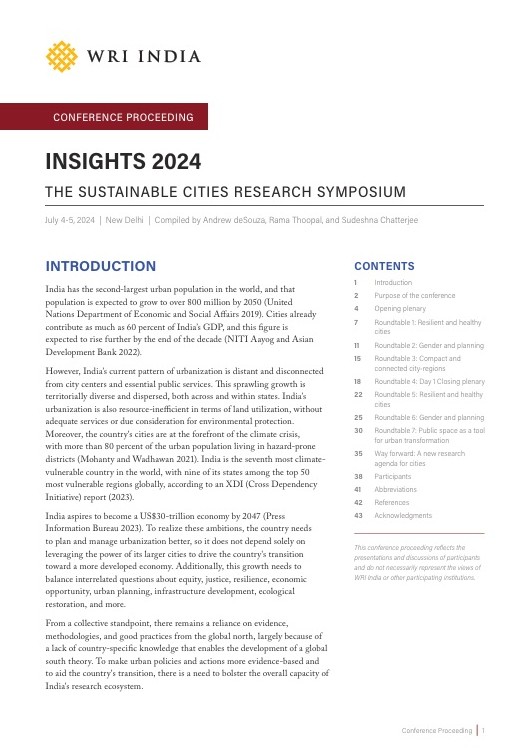Inclusivity as a climate action planning strategy
by , e -
This blog was originally posted on NIUA.org
The COVID-19 pandemic has hit health, livelihoods, and the economy across India. It is an added threat to the risk that climate change poses to development and shared prosperity. Similar to the pandemic, the impacts of climate change, especially extreme weather events, are also felt disproportionately by the poor and the marginalized. During the lockdown, when Cyclone Amphan hit the east coast of India and Cyclone Nisarga made landfall on the west coast, local governments had to work through competing goals of lockdown and evacuation to keep communities safe.
Governments in India, both at the centre and the state level, are not only working to reduce the impacts of the ongoing pandemic but also need to lay foundations to deal with the ongoing climate crisis. India is committed to the goals of The Paris Agreement to reduce climate risk while alleviating poverty, building shared prosperity, and promoting sustainable development. That is where inclusive climate action planning can help local governments assess climate-related risks and identify actions that are consistent with the country’s climate goals.
Inclusivity is the practice of engaging relevant stakeholders during the policy-making processes to help create equity. It also helps ensure fairness and accessibility of policy process while leading to an equitable impact of climate programmes, actions, and policies. Climate change can exacerbate the pre-existing inequalities in a region, therefore, policy-makers, citizens, and relevant stakeholder groups must join hands in addressing this challenge.
Ministry of Housing & Urban Affairs’ (MOHUA) Climate SMART Cities Assessment Framework (CSCAF) provides a roadmap to integrate climate action into urban development across Indian cities. Here are some examples of cities that adopted different elements of inclusivity in their climate actions.
Inclusivity of Process
Due to high average temperatures during summer, and an increase in the average temperatures over the years, in 2015 Ahmedabad (Gujarat) became the first city in India with a Heat Action Plan. A heat alert action is triggered by forecast of temperatures. Yellow is for temperatures ranging between 41.1-43 degrees Celsius, Orange for 43.1-45 degrees Celsius and Red for temperatures greater than 45 degrees Celsius. The nodal officer issues an alert to the concerned stakeholders including the State Disaster Management Authority, non-governmental groups such as community help groups, mobile service providers and media outreach. The alert is also sent to utility companies, health centres, religious groups, and school boards, among others. The plan identifies a checklist for each stakeholder and action items based on the alert category. This process is inclusive because it directly alerts community groups that can promptly aid the most vulnerable people, such as labourers, poor and homeless groups.
Inclusivity of Policy
Uttar Pradesh is among India’s five worst-hit states due to air pollution. One of the ways to address the adverse health impacts of air pollution is by allocating sufficient and long-term funding for emission reduction technologies. In its Electric Vehicles Manufacturing Policy 2018, the state set a goal of achieving 100% electrification of autorickshaws, cabs, school buses/vans, etc., by 2030 in five cities: GB Nagar (Noida), Lucknow, Kanpur, Varanasi, and Ghaziabad. This policy created an enabling environment for innovation, not just on technologies but also on financing models. One example is SMV Green, a social venture that provides loans and cost subsidies to rickshaw workers for EV battery exchange. This finance model exemplifies inclusivity of policy as it alleviates access to funds and EV technology for rickshaw workers across the state.
Inclusivity of Impact
Until 2017 Diu Smart City, located on the western coast of India, was dependent on Gujarat for its electricity. Diu adopted a two-pronged approach to become energy independent and reduce emissions. It commissioned a 9MW solar park and promoted roof-top solar. The city installed solar panels on government buildings, generating 1.3 MW of power, and offered subsidies of INR 10,000 to 50,000 to its residents for installing solar panels. As a result, in 2018 Diu became the first city in India to run on 100% renewables during the daytime. The city is also mitigating emissions of 13,000 tonnes CO2 per year. Moreover, residents of Diu have seen a significant reduction in their electricity bills. This case illustrates the inclusivity of impact because it provided affordable access to reliable energy.
In conclusion, inclusive climate action planning must include:
(1) processes that engage with impacted stakeholder groups
(2) policies that are designed to keep people at the centre of decision making
(3) mechanisms that direct and distribute the impact equitably across citizen groups
While each city must respond to its citizens’ needs, local context, geography and culture, this can also be an opportunity to share learning with other cities.
Faiza Solanki works as an EPP consultant with the Climate Program at WRI India.
Views expressed here are the author’s own.


